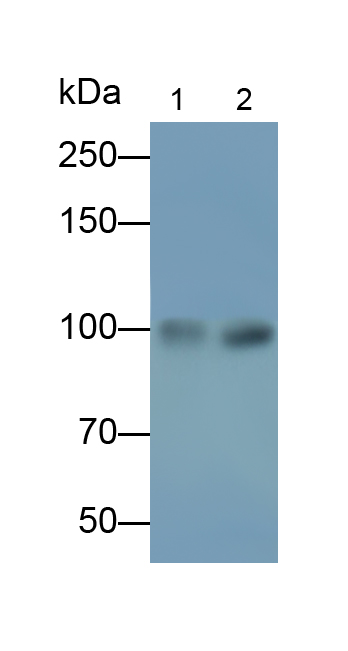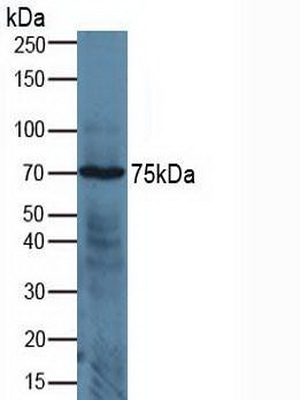Polyclonal Antibody to A Disintegrin And Metalloprotease 17 (ADAM17)
CD156b; TACE; CSVP; Tumor Necrosis Factor,Alpha,Converting Enzyme; Disintegrin and metalloproteinase domain-containing protein 17; Snake venom-like protease
- Product No.PAB555Hu01
- Organism SpeciesHomo sapiens (Human) Same name, Different species.
- SourcePolyclonal antibody preparation
- HostRabbit
- Potencyn/a
- Ig Type IgG
- PurificationAntigen-specific affinity chromatography followed by Protein A affinity chromatography
- LabelNone
- Immunogen RPB555Hu01-Recombinant A Disintegrin And Metalloprotease 17 (ADAM17)
- Buffer FormulationPBS, pH7.4, containing 0.02% NaN3, 50% glycerol.
- TraitsLiquid
- Concentration0.3mg/mL
- Organism Species Moren/a
- ApplicationsWB; IHC; ICC; IP.
If the antibody is used in flow cytometry, please check FCM antibodies. - DownloadInstruction Manual
- UOM 20µl100µl 200µl 1ml 10ml
- FOB
US$ 79
US$ 183
US$ 262
US$ 655
US$ 2620
For more details, please contact local distributors!
SPECIFITY
The antibody is a rabbit polyclonal antibody raised against ADAM17. It has been selected for its ability to recognize ADAM17 in immunohistochemical staining and western blotting.
USAGE
Western blotting: 0.01-2µg/mL
Immunohistochemistry: 5-20µg/mL
Immunocytochemistry: 5-20µg/mL
Optimal working dilutions must be determined by end user.
STORAGE
Store at 4°C for frequent use. Stored at -20°C in a manual defrost freezer for two year without detectable loss of activity. Avoid repeated freeze-thaw cycles.
STABILITY
The thermal stability is described by the loss rate. The loss rate was determined by accelerated thermal degradation test, that is, incubate the protein at 37°C for 48h, and no obvious degradation and precipitation were observed. The loss rate is less than 5% within the expiration date under appropriate storage condition.
GIVEAWAYS
INCREMENT SERVICES
-
 Antibody Labeling Customized Service
Antibody Labeling Customized Service
-
 Protein A/G Purification Column
Protein A/G Purification Column
-
 Staining Solution for Cells and Tissue
Staining Solution for Cells and Tissue
-
 Positive Control for Antibody
Positive Control for Antibody
-
 Tissue/Sections Customized Service
Tissue/Sections Customized Service
-
 Phosphorylated Antibody Customized Service
Phosphorylated Antibody Customized Service
-
 Western Blot (WB) Experiment Service
Western Blot (WB) Experiment Service
-
 Immunohistochemistry (IHC) Experiment Service
Immunohistochemistry (IHC) Experiment Service
-
 Immunocytochemistry (ICC) Experiment Service
Immunocytochemistry (ICC) Experiment Service
-
 Flow Cytometry (FCM) Experiment Service
Flow Cytometry (FCM) Experiment Service
-
 Immunoprecipitation (IP) Experiment Service
Immunoprecipitation (IP) Experiment Service
-
 Immunofluorescence (IF) Experiment Service
Immunofluorescence (IF) Experiment Service
-
 Buffer
Buffer
-
 DAB Chromogen Kit
DAB Chromogen Kit
-
 SABC Kit
SABC Kit
-
 Long-arm Biotin Labeling Kit
Long-arm Biotin Labeling Kit
-
 Real Time PCR Experimental Service
Real Time PCR Experimental Service
| Magazine | Citations |
| Int Wound J. | From varices to venous ulceration: the story of chronic venous disease described by metalloproteinases. Pubmed:26991748 |
| International Wound Journal | From varices to venous ulceration: the story of chronic venous disease described by metalloproteinases pubmed:26991748 |
| Biomedical Research | ADAM17 regulates TNF-α expression upon lipopolysaccharide stimulation in oral keratinocytes. pubmed:28637950 |
| Cytometry B Clin Cytom | L‐Selectin Expression Is Influenced by Phosphatase Activity in Chronic Lymphocytic Leukemia Pubmed: 30729673 |
| Disease Markers | Adamalysines as Biomarkers and a Potential Target of Therapy in Colorectal Cancer Patients: Preliminary Results Pubmed: 31565100 |
| Chem Biol Interact | PEG-SOD attenuates the mitogenic ERK1/2 signaling cascade induced by cyclosporin A in the liver and kidney of albino mice Pubmed: 32866465 |
| life | High Levels of TNF-¦Á and TIM-3 as a Biomarker of Immune Reconstitution Inflammatory Syndrome in People with HIV Infection |









